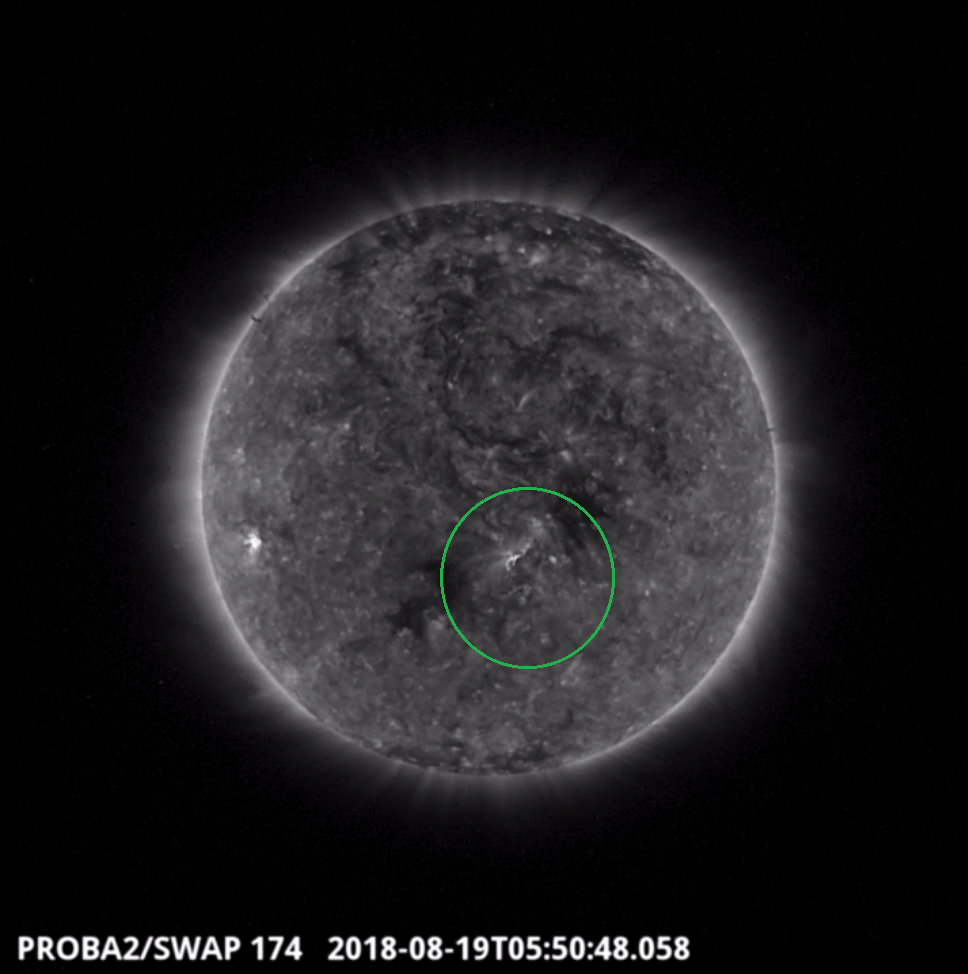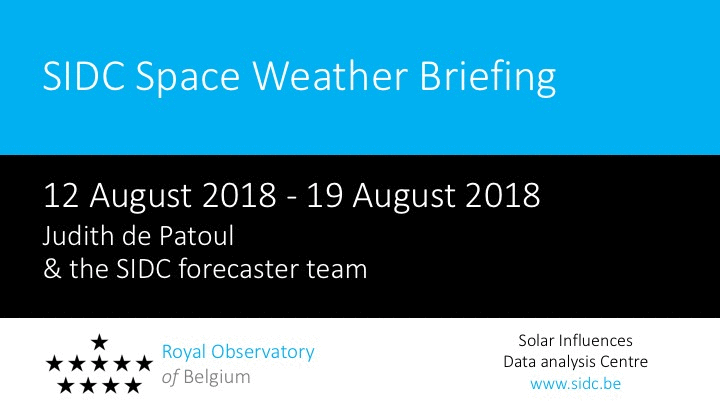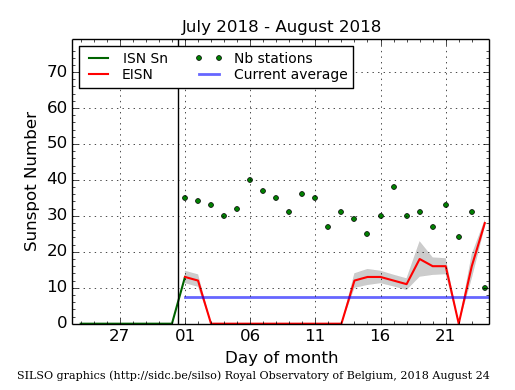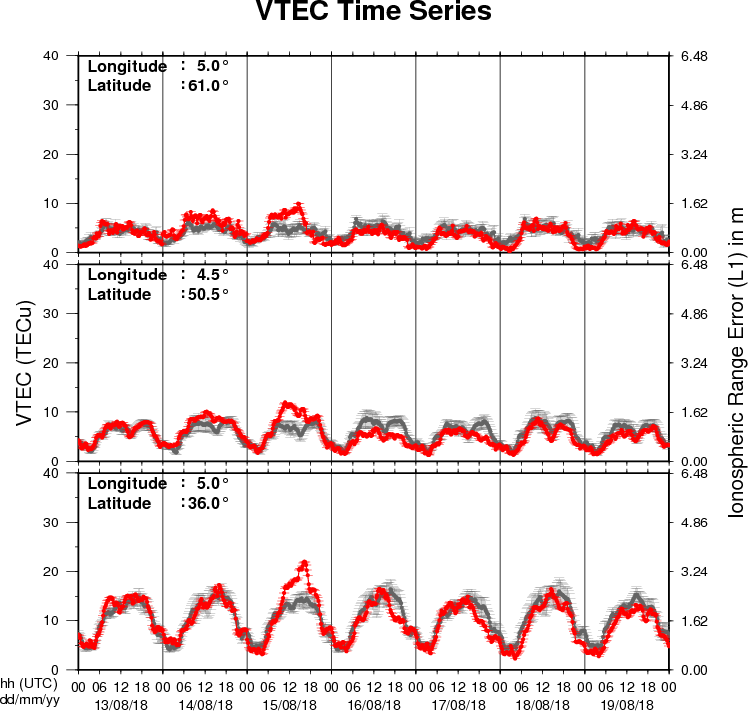- Table of Content
- 1.STCE at the pa...
- 2.PROBA2 Observa...
- 3.Review of sola...
- 4.The SIDC space...
- 5.The Internatio...
- 6.Geomagnetic Ob...
- 7.Review of iono...
2. PROBA2 Observations (13 Aug 2018 - 19 Aug 2018)
3. Review of solar and geomagnetic activity
4. The SIDC space weather Briefing
5. The International Sunspot Number
6. Geomagnetic Observations at Dourbes (13 Aug 2018 - 19 Aug 2018)
7. Review of ionospheric activity (13 Aug 2018 - 19 Aug 2018)
STCE at the parc
On August 18, 'Night of Wolvendael' invited small and big people to spend the night in a tent in the parc in Ukkel, Belgium. Another event than the usual ones! Of course, STCE was present:
'Tales from the northern light' told the real story why aurora borealis exists. The dancing colours come from a scarf in all the colours of the rainbow, contrary to the scientific explanation that it is linked with the solar wind bumping on the magnetic shield of Earth.
'Ringing Sunspots' let you experience how high or low and how long a solar cycle is. Some solar cycles are more difficult to pass without hearing a buzz, some maximum make it extra challenging because of the double peak.
BRAMS, Belgian Radio Meteor Stations, showed a receiving antenna that can detect meteors passing through the atmosphere.
An impression:

The 'Ringing Sunspots' explained: http://www.stce.be/presentations/general/20180819_Wolvendael_sunspots_runningpresentation_Eng.ppsm
PROBA2 Observations (13 Aug 2018 - 19 Aug 2018)
Solar Activity
Solar flare activity remained very low during the week.
In order to view the activity of this week in more detail, we suggest to go to the following website from which all the daily (normal and difference) movies can be accessed: http://proba2.oma.be/ssa
This page also lists the recorded flaring events.
A weekly overview movie can be found here (SWAP week 438): http://proba2.oma.be/swap/data/mpg/movies/weekly_movies/weekly_movie_2018_08_13.mp4
Details about some of this week's events, can be found further below.
Sunday Aug 19
If any of the linked movies are unavailable they can be found in the P2SC movie repository here: http://proba2.oma.be/swap/data/mpg/movies/

An eruption and dimming were observed by SWAP in the south west quadrant of the solar disk on 2018-Aug-19, as shown in the SWAP image above taken at 05:50 UT.
Find a movie of the event here (SWAP movie): http://proba2.oma.be/swap/movies/20180819_swap_movie.mp4 and here (SWAP difference movie): http://proba2.oma.be/swap/movies/20180819_swap_diff.mp4
Review of solar and geomagnetic activity
Solar activity
The solar activity has been quiet and no significant flare has been recorded, the X-ray flux remained below B-level for the whole week.
A Coronal Mass Ejection (CME) has been observed. It was associated with a long lasting A(!)-class flare (August 19 at 05:44 UT, NOAA-region 2718) followed by a dimming close to the Sun centre. From the Stereo COR2 images the radial speed was estimated around 1000 km/s. Given the narrow angular width (around 10-degree, in by SoHO/LASCO-C2 coronagraph) and the South-West direction of the ejecta, no Earth directed component was identified. The solar protons flux remained at nominal levels over the past 24 hours and is expected to remain so.
Geomagnetic activity
The solar wind parameters measured at L1 were enhanced due to the up-stream solar wind associated with a positive polarity north pole coronal hole that reached the central meridian on August 11. The wind speed rose form about 320 km/s early in the week to 575 km/s on August 17 around 19:30 UT. The magnitude of the Interplanetary Magnetic Field reached about 11 nT, while the southward component reached -10 nT. Close to the end of the week, the solar wind activity declined, to then be re-enhanced on August 19 in the afternoon due to the arrival of the fast solar wind associated with a negative polarity equatorial coronal hole that reached the central meridian on August 17.
The geomagnetic conditions were mainly quiet to unsettled, with short period of active conditions (K-index (Dourbes) and Kp-index (NOAA) = 4) due to the solar wind enhancement.
The SIDC space weather Briefing
The Space Weather Briefing presented by the forecaster on duty from August 13 to 19. It reflects in images and graphs what is written in the Solar and Geomagnetic Activity report.

pdf version: http://www.stce.be/briefings/SIDCbriefing-20180820.pdf
automatically running slideshow: http://www.stce.be/briefings/SIDCbriefing-20180820.ppsm
The International Sunspot Number
A slightly 'more busy' week:

The daily Estimated International Sunspot Number (EISN, red curve with shaded error) derived by a simplified method from real-time data from the worldwide SILSO network. It extends the official Sunspot Number from the full processing of the preceding month (green line). The plot shows the last 30 days (about one solar rotation). The horizontal blue line shows the current monthly average, while the green dots give the number of stations included in the calculation of the EISN for each day.
Review of ionospheric activity (13 Aug 2018 - 19 Aug 2018)

The figure shows the time evolution of the Vertical Total Electron Content (VTEC) (in red) during the last week at three locations:
a) in the northern part of Europe(N61°, 5°E)
b) above Brussels(N50.5°, 4.5°E)
c) in the southern part of Europe(N36°, 5°E)
This figure also shows (in grey) the normal ionospheric behaviour expected based on the median VTEC from the 15 previous days.
The VTEC is expressed in TECu (with TECu=10^16 electrons per square meter) and is directly related to the signal propagation delay due to the ionosphere (in figure: delay on GPS L1 frequency).
The Sun's radiation ionizes the Earth's upper atmosphere, the ionosphere, located from about 60km to 1000km above the Earth's surface.The ionization process in the ionosphere produces ions and free electrons. These electrons perturb the propagation of the GNSS (Global Navigation Satellite System) signals by inducing a so-called ionospheric delay.
See http://stce.be/newsletter/GNSS_final.pdf for some more explanations ; for detailed information, see http://gnss.be/ionosphere_tutorial.php
